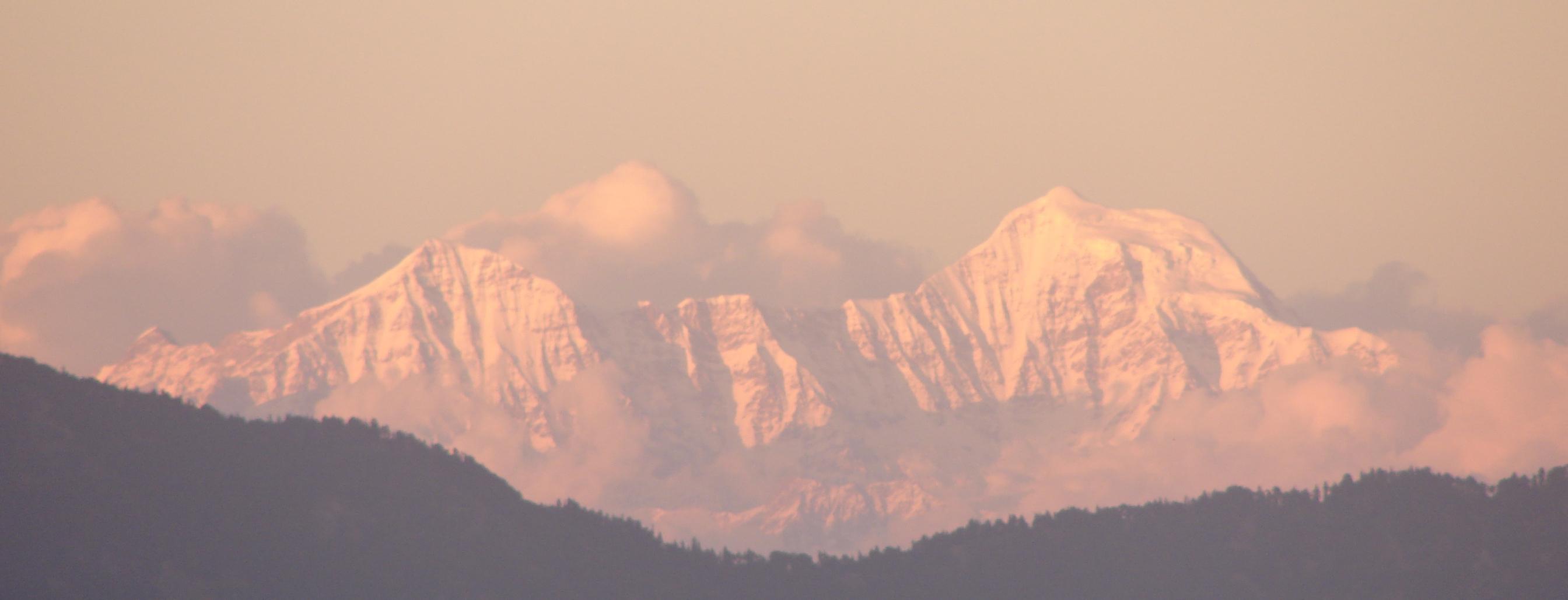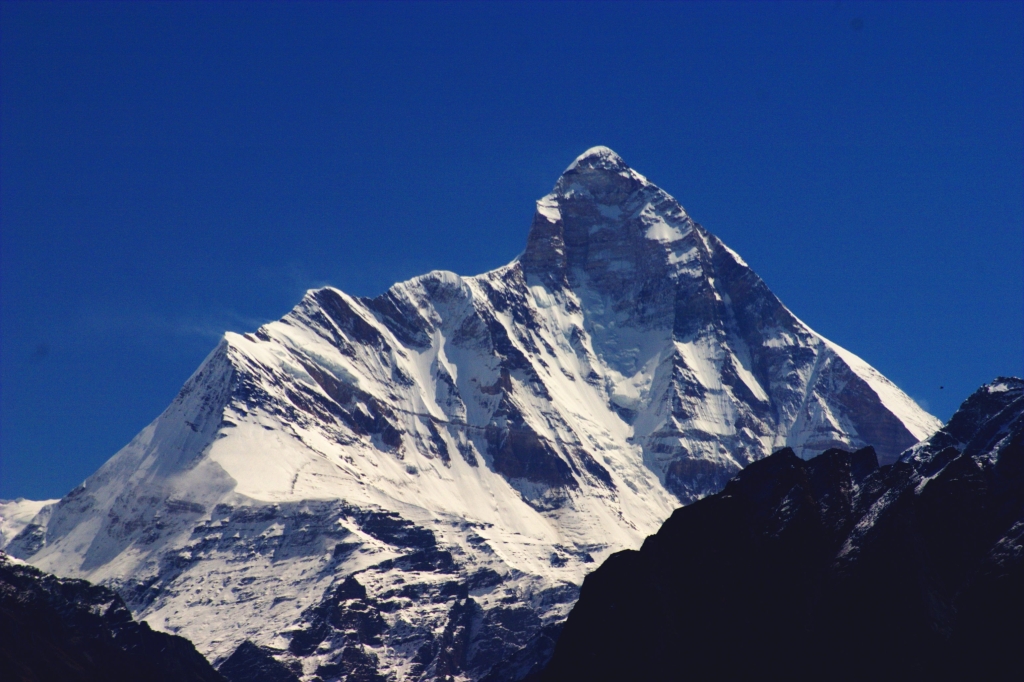Kalpeshwar on:
[Wikipedia]
[Google]
[Amazon]
Kalpeshwar ( sa, कल्पेश्वर) is a Hindu temple dedicated to Shiva located at an elevation of in the picturesque Urgam valley in the

 The Kalpeshwar temple is located in the Urgam valley of the Himalayan mountain range near Urgam village ( short of the temple). On the bridle path from Helang to Kalpeshwar, the confluence of the Alaknanda and Kalpganga rivers is seen. Kalpganga river flows through the Urgam valley. The Urgam valley is a dense forest area. The valley has apple orchards and terraced fields where potato is grown extensively.
The Kalpeshwar temple is located in the Urgam valley of the Himalayan mountain range near Urgam village ( short of the temple). On the bridle path from Helang to Kalpeshwar, the confluence of the Alaknanda and Kalpganga rivers is seen. Kalpganga river flows through the Urgam valley. The Urgam valley is a dense forest area. The valley has apple orchards and terraced fields where potato is grown extensively.
Locations of Panch Kedar - Schematic sketch
Panch Kedar, trek map, page 78
{{Shiva temples Shiva temples in India Hindu temples in Uttarakhand Panch Kedar
Garhwal Garhwal may refer to the following topics associated with Uttarakhand, India:
Places
*Garhwal Himalaya, a sub-range of the Himalayas
*Garhwal Kingdom, a former kingdom
* Garhwal District (British Garhwal), a former district of British India
*Gar ...
region of Uttarakhand state in India. The temple's ancient legend linked to the Pandavas, heroes of the epic Mahabharata, is the fifth temple of the Panch Kedar (five temples) of Shiva's five anatomical divine forms; the other four temples in the order of their worship are Kedarnath, Rudranath, Tungnath and Madhyamaheshwar temples; all in the Kedar Khand region of the Garhwal Garhwal may refer to the following topics associated with Uttarakhand, India:
Places
*Garhwal Himalaya, a sub-range of the Himalayas
*Garhwal Kingdom, a former kingdom
* Garhwal District (British Garhwal), a former district of British India
*Gar ...
Himalayas. Kalpeshwar is the only Panch Kedar temple accessible throughout the year. At this small stone temple, approached through a cave passage, the matted tress (''jata'') of Lord Shiva is worshipped. Hence, Lord Shiva is also called as Jatadhar or Jateshwar. Earlier it was approachable only by trek from the nearest road head of Helang on the Rishikesh
Rishikesh, also spelt as Hrishikesh, is a city near Dehradun in Dehradun district of the Indian state Uttarakhand. It is situated on the right bank of the Ganges River and is a pilgrimage town for Hindus, with ancient sages and saints meditati ...
- Badrinath road but now the road goes up to Devgram village from where the trek now is just 300 metres. This road is good for bikes or cars with good ground clearance as it is a half-paved road which may get damaged during monsoons. Small cars can be taken except in monsoons.
Legend
Many folk legends related to the Garhwal region, Lord Shiva and the creation of the Panch Kedar temples are narrated. A folk legend about Panch Kedar relates to the Pandavas, the heroes of the Hindu epic Mahabharata. The Pandavas defeated and slayed their cousins — the Kauravas in the epicKurukshetra war
The Kurukshetra War ( sa, कुरुक्षेत्र युद्ध ), also called the Mahabharata War, is a war described in the ''Mahabharata ( sa, महाभारत )''. The conflict arose from a dynastic succession struggle be ...
. They wished to atone for the sins of committing fratricide (''gotra
In Hindu culture, the term gotra (Sanskrit: गोत्र) is considered to be equivalent to lineage. It broadly refers to people who are descendants in an unbroken male line from a common male ancestor or patriline. Generally, the gotra fo ...
hatya'') and Brāhmanahatya (killing of Brahmins — the priest class) during the war. Thus, they handed over the reins of their kingdom to their kin and left in search of lord Shiva and to seek his blessings. First, they went to the holy city of Varanasi (Kashi), believed to be Shiva's favourite city and known for its Kashi Vishwanath Temple. But, Shiva wanted to avoid them as he was deeply incensed by the death and dishonesty at the Kurukshetra war and was, therefore, insensitive to Pandavas' prayers. Therefore, he assumed the form of a bull (Nandi
Nandi may refer to:
People
* Nandy (surname), Indian surname
* Nandi (mother of Shaka) (1760–1827), daughter of Bhebe of the Langeni tribe
* Onandi Lowe (born 1974), Jamaican footballer nicknamed Nandi
* Nandi Bushell (born 2010), South Afri ...
) and hid in the Garhwal region.
Not finding Shiva in Varanasi, the Pandavas went to Garhwal Garhwal may refer to the following topics associated with Uttarakhand, India:
Places
*Garhwal Himalaya, a sub-range of the Himalayas
*Garhwal Kingdom, a former kingdom
* Garhwal District (British Garhwal), a former district of British India
*Gar ...
Himalayas. Bhima
In Hindu epic Mahabharata, Bhima ( sa, भीम, ) is the second among the five Pandavas. The ''Mahabharata'' relates many events that portray the might of Bhima. Bhima was born when Vayu, the wind god, granted a son to Kunti and Pandu. Af ...
, the second of the five Pandava brothers, then standing astride two mountains started to look for Shiva. He saw a bull grazing near Guptakashi (“hidden Kashi” — the name derived from the hiding act of Shiva). Bhima immediately recognized the bull to be Shiva. Bhima caught hold of the bull by its tail and hind legs. But the bull-formed Shiva disappeared into the ground to later reappear in parts, with the hump raising in Kedarnath, the arms appearing in Tungnath, the face showing up at Rudranath, the nabhi (navel) and stomach surfacing in Madhyamaheshwar and the hair appearing in Kalpeshwar. The Pandavas pleased with this reappearance in five different forms, built temples at the five places for venerating and worshipping Shiva. The Pandavas were thus freed from their sins.
A variant of the tale credits Bhima of not only catching the bull, but also stopping it from disappearing. Consequently, the bull was torn asunder into five parts and appeared at five locations in the Kedar Khand Kedar and Qedar may refer to: Indian subcontinent
*Shiva or Kedar, a Hindu god
**Panch Kedar, five Hindu temples or holy places of the Shaivite sect dedicated to god Shiva
*Kedar (raga), a raga in Indian classical music named after Lord Shiva
*Kedar ...
of Garhwal region of the Himalayas. After building the Panch Kedar Temples, the Pandavas meditated at Kedarnath for salvation, performed yagna (fire sacrifice) and then through the heavenly path called the Mahapanth (also called Swargarohini), attained heaven or salvation.. The Panch Kedar Temples are constructed in the North-Indian Himalayan Temple architecture with the Kedarnath, Tungnath and Madhyamaheshwar temples looking similar.
After completing the pilgrimage of Lord Shiva's darshan at the Panch Kedar Temples, it is an unwritten religious rite to visit Lord Vishnu at the Badrinath Temple, as a final affirmatory proof by the devotee that he has sought blessings of Lord Shiva.
Many folk legends related to the Garhwal region, Lord Shiva and the creation of the Panch Kedar temples are narrated.
;Worship
The temple priests at this temple also are the Dasnamis and Gossains, disciples of Adi Shankara. At Tungnath also the priests are Khasiya Brahmins. These priests hail from South India; the Namboodiri brahminfrom Kerala sect who worship at Badrinath. at Kedarnath, the Jangama
The Jangam or Jangamaru (ಜಂಗಮರು) are a Shaiva order of religious monks. They are the priests or gurus of the Hindu Shaiva sect. Jangamas are also gurus of Veerashaiva' sect
Jangamas are disciples of Lord Shiva as mentioned in Bas ...
s are lingayats from Mysore in Karnataka. In all these temples the pooja is designed by adi sankara. these priests also are supposed to be appointed by Adi Shankara. The priests at the Rudranath temple are Dasnamis and Gosains.
Geography

 The Kalpeshwar temple is located in the Urgam valley of the Himalayan mountain range near Urgam village ( short of the temple). On the bridle path from Helang to Kalpeshwar, the confluence of the Alaknanda and Kalpganga rivers is seen. Kalpganga river flows through the Urgam valley. The Urgam valley is a dense forest area. The valley has apple orchards and terraced fields where potato is grown extensively.
The Kalpeshwar temple is located in the Urgam valley of the Himalayan mountain range near Urgam village ( short of the temple). On the bridle path from Helang to Kalpeshwar, the confluence of the Alaknanda and Kalpganga rivers is seen. Kalpganga river flows through the Urgam valley. The Urgam valley is a dense forest area. The valley has apple orchards and terraced fields where potato is grown extensively.
Access
Access to Kalpeshwar by road up to Urgam is from Rishikesh, a distance of on theRishikesh
Rishikesh, also spelt as Hrishikesh, is a city near Dehradun in Dehradun district of the Indian state Uttarakhand. It is situated on the right bank of the Ganges River and is a pilgrimage town for Hindus, with ancient sages and saints meditati ...
- Badrinath road. Earlier the trek route existed from Helang to Kalpeshwar via Urgam village for a distance of . But now a good jeep-able road is constructed from Helang to Devgram so from Urgam it's just 300 meters trek to reach Kalpeshwar temple . Only Bolero, Thar or Gurkha are vehicles suitable for the Road. The road is very rough and not suitable to normal cars. Beginner drivers should refrain from driving on this road. The nearest airport is at Jolly Grant, Dehradun
Dehradun () is the capital and the most populous city of the Indian state of Uttarakhand. It is the administrative headquarters of the eponymous district and is governed by the Dehradun Municipal Corporation, with the Uttarakhand Legislative As ...
at a distance of and the nearest railhead, Rishikesh, is .
Boodha Kedar temple surrounded by potato fields is seen on the trek route. Also seen is the Dhyan Badri temple at Urgam Village, one of the Sapt Badri (seven Badri) temples.
References
External links
Locations of Panch Kedar - Schematic sketch
Panch Kedar, trek map, page 78
{{Shiva temples Shiva temples in India Hindu temples in Uttarakhand Panch Kedar